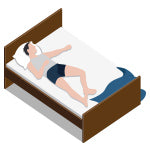Are you wondering what the best sleeping position is if you have back pain? Between six and eight out of ten people experience back pain to varying degrees at some point in their lives. If this is the case for you, one way to remedy or at least alleviate your problem is to follow some posture recommendations and implement simple habits into your daily routine.
There are many tips you can apply to try to alleviate or prevent back pain. One of the most effective is to control the positions you adopt during sleep. Wondering why? It's simple! Because when you sleep, your muscles relax, and your body can work at a higher rate to repair itself. However, it may be precisely your sleep habits and posture that are causing those annoying pains. Good sleep is fundamental to living well!
As specialists in the best rest, at Vilma Sleep, we not only offer you top-quality products to help you sleep better; on our blog, we also share useful tips to help you rest as you deserve. In this article, we help you find the best sleeping position if you have back pain. Stick with us and take note of all our tips!
The Best Sleeping Positions if You Suffer from Back Pain
The best sleeping position if you have back pain is on your side, although sleeping on your back is also a good option if it's more comfortable for you, but be careful; there are a few points to consider to benefit from this position. Let's go through all the keys!
On Your Side. The Best Position

Experts indicate that the best sleeping position to avoid back and neck pain is on your side. There's even a more recommended side to protect your back, lumbar, and neck.
According to specialists, the optimal position to combat back pain is lying on your left side and in a fetal position. If you also want to avoid discomfort in your knees or legs, you can place a pillow between your legs to reduce the pressure one would exert on the other.
Advocates of this position point out that it best respects the natural curvature of the spine, but they also indicate that for it to be effective, it's important to have your head well supported on a pillow aligned with the rest of your body. Placing a cushion between your legs will also assist in this case.
On Your Back. A Good Alternative

If your back problems prevent you from sleeping on your side or if this position is uncomfortable for you, a good alternative is to sleep on your back.
If you choose this position, it's recommended to place a pillow or cushion under your knees to help maintain the natural curvature of the spine.
Remember to support your neck with a good pillow that allows you to relax your neck without straining it.
Do You Have Back Pain When Sleeping on Your Back?
If you sleep on your back and experience back pain even with a pillow between your knees, you may need extra support. Try placing a rolled-up hand towel under the lower part of your back to relieve tension on the lumbar area.
On the other hand, if the pain is concentrated in the neck area, you may need to change your pillow. For sleeping on your back, the most recommended pillow is a low one that allows your neck to remain aligned with the rest of your spine.
Finally, the issue may lie with your mattress. If it's too old or doesn't have the right firmness, it may not be supporting your weight properly. In such cases, it's advisable to replace it with a new mattress tailored to your needs.
Tips to Prevent Back Pain
Now that you know the best sleeping positions if you have back pain, let's quickly go through some habits you can also adopt in your daily life to combat this problem:
- Keep your phone away from the bed: Using phones and tablets while lying down or holding them on your lap is one of the most harmful postures for your back and neck.
- Relieve pain with self-massages on the back: Try pressing with your thumb on contracted points for about a minute; you should notice a decrease in discomfort.
- Adopt correct postures when using screens: Try to keep your back and neck straight and avoid tilting your head.
- Apply this posture before sleeping to "smooth" the back: Lie on the floor or bed as close as possible to the wall and put your coccyx against it. Then, raise your legs and lean them against the wall. Maintain the position without tensing your muscles to stretch your back and relieve tension.
YOU MAY ALSO BE INTERESTED IN:
- Sleeping on your stomach: is it bad, or is it beneficial?
- Sleeping without a pillow: Is it bad for your health?
- Sleeping with your mouth open can cause problems?
- How to sleep well during pregnancy: Tips and positions
- The best pillows according to your sleeping position
- How to choose the right mattress for you

